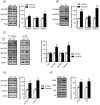Essential role of D1R in the regulation of mTOR complex1 signaling induced by cocaine
- PMID: 26314207
- PMCID: PMC4703076
- DOI: 10.1016/j.neuropharm.2015.08.024
Essential role of D1R in the regulation of mTOR complex1 signaling induced by cocaine
Abstract
The mammalian target of rapamycin (mTOR) is a serine/threonine kinase that is involved in neuronal adaptions that underlie cocaine-induced sensitization and reward. mTOR exists in two functionally distinct multi-component complexes known as mTORC1 and mTORC2. In this study, we show that increased mTORC1 activity induced by cocaine is mediated by the dopamine D1 receptor (D1R). Specifically, cocaine treatment increased the phosphorylation on residues Thr2446 and Ser2481 but not on Ser2448 in the nucleus accumbens (NAc) and that this increase in phosphorylated mTOR levels was also apparent when complexed with its binding partner Raptor. Furthermore, the increase in phosphorylated mTOR levels, as well as phosphorylated 4E-BP1 and S6K, downstream targets of mTORC1 were blocked with SCH23390 treatment. Similar results were also observed in the dopamine-transporter knockout mice as the increase in phosphorylated mTOR Thr2446 and Ser2481 was blocked by SCH23390 but not with raclopride. To further validate D1R role in mTORC1 signaling, decrease in phosphorylated mTOR levels were observed in D1R knockout mice, whereas administration of SKF81297 elevated phosphorylated mTOR in the NAc. Lastly deletion of mTOR or Raptor in D1R expressing neurons reduced cocaine-induced locomotor activity. Together, our data supports a mechanism whereby mTORC1 signaling is activated by cocaine administration through the stimulation of D1R.
Keywords: Cell signaling; Cocaine; Dopamine; Nucleus accumbens; Raptor; mTOR.
Copyright © 2015 Elsevier Ltd. All rights reserved.
Figures





Similar articles
-
VTA mTOR Signaling Regulates Dopamine Dynamics, Cocaine-Induced Synaptic Alterations, and Reward.Neuropsychopharmacology. 2018 Apr;43(5):1066-1077. doi: 10.1038/npp.2017.247. Epub 2017 Oct 17. Neuropsychopharmacology. 2018. PMID: 29039413 Free PMC article.
-
The First Alcohol Drink Triggers mTORC1-Dependent Synaptic Plasticity in Nucleus Accumbens Dopamine D1 Receptor Neurons.J Neurosci. 2016 Jan 20;36(3):701-13. doi: 10.1523/JNEUROSCI.2254-15.2016. J Neurosci. 2016. PMID: 26791202 Free PMC article.
-
Cocaine-Dependent Acquisition of Locomotor Sensitization and Conditioned Place Preference Requires D1 Dopaminergic Signaling through a Cyclic AMP, NCS-Rapgef2, ERK, and Egr-1/Zif268 Pathway.J Neurosci. 2021 Jan 27;41(4):711-725. doi: 10.1523/JNEUROSCI.1497-20.2020. Epub 2020 Dec 2. J Neurosci. 2021. PMID: 33268547 Free PMC article.
-
Repeated stimulation of dopamine D1-like receptor and hyperactivation of mTOR signaling lead to generalized seizures, altered dentate gyrus plasticity, and memory deficits.Hippocampus. 2014 Dec;24(12):1466-81. doi: 10.1002/hipo.22327. Epub 2014 Jul 23. Hippocampus. 2014. PMID: 25044816
-
Acute cocaine induces fast activation of D1 receptor and progressive deactivation of D2 receptor striatal neurons: in vivo optical microprobe [Ca2+]i imaging.J Neurosci. 2011 Sep 14;31(37):13180-90. doi: 10.1523/JNEUROSCI.2369-11.2011. J Neurosci. 2011. PMID: 21917801 Free PMC article.
Cited by
-
Reading LINEs within the cocaine addicted brain.Brain Behav. 2017 Apr 6;7(5):e00678. doi: 10.1002/brb3.678. eCollection 2017 May. Brain Behav. 2017. PMID: 28523221 Free PMC article.
-
Dopamine Receptor D3 Induces Transient, mTORC1-Dependent Autophagy That Becomes Persistent, AMPK-Mediated, and Neuroprotective in Experimental Models of Huntington's Disease.Cells. 2025 Apr 29;14(9):652. doi: 10.3390/cells14090652. Cells. 2025. PMID: 40358175 Free PMC article.
-
VTA mTOR Signaling Regulates Dopamine Dynamics, Cocaine-Induced Synaptic Alterations, and Reward.Neuropsychopharmacology. 2018 Apr;43(5):1066-1077. doi: 10.1038/npp.2017.247. Epub 2017 Oct 17. Neuropsychopharmacology. 2018. PMID: 29039413 Free PMC article.
-
Distinct Regulation of Dopamine D3 Receptor in the Basolateral Amygdala and Dentate Gyrus during the Reinstatement of Cocaine CPP Induced by Drug Priming and Social Stress.Int J Mol Sci. 2021 Mar 18;22(6):3100. doi: 10.3390/ijms22063100. Int J Mol Sci. 2021. PMID: 33803578 Free PMC article.
-
MPTP Impairs Dopamine D1 Receptor-Mediated Survival of Newborn Neurons in Ventral Hippocampus to Cause Depressive-Like Behaviors in Adult Mice.Front Mol Neurosci. 2016 Oct 13;9:101. doi: 10.3389/fnmol.2016.00101. eCollection 2016. Front Mol Neurosci. 2016. PMID: 27790091 Free PMC article.
References
-
- Beaulieu JM, Sotnikova TD, Yao WD, Kockeritz L, Woodgett JR, Gainetdinov RR, Caron MG. Lithium antagonizes dopamine-dependent behaviors mediated by an AKT/glycogen synthase kinase 3 signaling cascade. Proceedings of the National Academy Sciences of the United States of America. 2004;101:5099–5104. - PMC - PubMed
-
- Biever A, Puighermanal E, Nishi A, David A, Panciatici C, Longueville S, Xirodimas D, Gangarossa G, Meyuhas O, Herve D, Girault JA, Valjent E. PKA-dependent phosphorylation of ribosomal protein S6 does not correlate with translation efficiency in striatonigral and striatopallidal medium-sized spiny neurons. J Neurosci. 2015;35:4113–4130. - PMC - PubMed
Publication types
MeSH terms
Substances
Grants and funding
LinkOut - more resources
Full Text Sources
Other Literature Sources
Molecular Biology Databases
Miscellaneous

